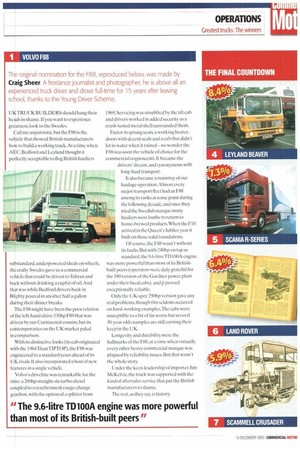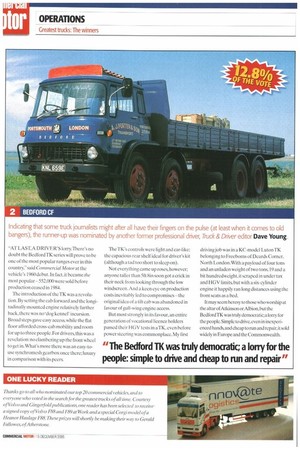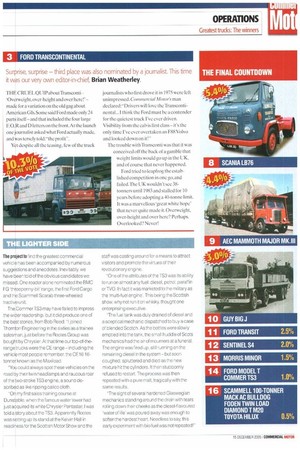Or fa votw e INIG 4o
Page 60

Page 61

Page 62

Page 63

If you've noticed an error in this article please click here to report it so we can fix it.
It"
tfIGS
CM'S centenary quest for the greatest ever commercial vehicle is finally over — and there's a clear winner...
The results are out: we can now reveal the nation's favourite commercial vehicle from the past 100 years. We were going to do a traditional reverse countdown, but you've probably seen from the front cover that the winner is... the Volvo F88. which gained more than a quarter of all the votes. That's twice as many as the runner-up, the Bedford TK.Third place went to the Ford Transcontinental.
Postal voting saw the AEC Mammoth Major take a clear lead,but it obviously doesn't appeal as much to the online community as it only managed to come ninth overall once we'd accounted for all postal and electronic votes. VOLVO F88
The original nomination for the F88, reproduced below, was made by Craig Sheer. A freelance journalist and photographer, he is above all an experienced truck driver and drove full-time for 15 years after leaving school, thanks to the Young Driver Scheme.
UKTRUCK BUILDERS should hang their heads in shame, If you want to experience greatness, look to the Swedes.
Call me unpatriotic, hut the F88 is the vehicle that showed British manufacturers how to build a working truck.At a time when AEC, Bedford and Leyland thought it perfectly acceptable to flog British hauliers substandard, underpowered sheds on wheels, the crafty Swedes gave us a commercial vehicle that could be driven to Tehran and back without drinking a cupful of oil. And that was while Bedford drivers back in Blighty poured in another half a gallon during their dinner breaks.
The F88 might have been the poor relation of the left-hand-drive 330hp F89 that was driven by our Continental cousins, hut its contemporaries on the UK market paled in comparison.
With its distinctive looks (its cab originated with the 1964 TitanTIPTOP), the F88 was engineered to a standard years ahead of its UK rivals. It also incorporated a host of new features in a single vehicle.
Volvo's drivcline was remarkable for the time:a 260hp straight-six turbo-diesel coupled to a synchromesh range-change gearbox, with the option of a splitter from 1969. Servicing was simplified by the tilt cab and drivers worked in added security as a crash-tested metal shell surrounded them.
Factor in sprung seats, a working heater, doors with decent seals and a cab that didn't let in water when it rained—no wonder the F88 was soon the vehicle of choice for the commercial cognoscenti. It became the drivers' dream, and synonymous with long-haul transport.
It also became a mainstay of our haulage operation. Almost every major transport fleet had an F88 among its ranks at some point during the following decade.and once they 7 tried the Swedish marque many hauliers were loathe to return to home-brewed products. When the F10 arrived in the Queen's Jubilee year it built on those solid foundations.
Of course, the F88 wasn't without its faults. But with 240hp on tap as standard. the 9.6-litre TD100A engine was more powerful than most of its Britishbuilt peers (operators were duly grateful for the 180 version of the Gardner power plant under their fixed cabs), and it proved exceptionally reliable.
Only the UK-spec 290hp version gave any real problems, though this seldom occurred on hard-working examples.The cabs were susceptible to a bit of tin worm hut several 30-year-old examples are still earning their keep in the UK.
Longevity and durability were the hallmarks of the F88, at a time when virtually every other heavy commercial marque was plagued by reliability issues. But that wasn't the whole story.
Under the keen leadership of importer Jim McKelvie, the truck was supported with the kind of aftersales service that put the British manufacturers to shame.
The rest, as they say. is history. "AT LAST,A DRIVER'S lorry.There's no doubt the BedfordTK series will prove to be one of the most popular ranges ever in this country,said Commercial Motor at the vehicle's 1960 debut. In fact, it became the most popular -552,000 were sold before production ceased in 1984.
The introduction of the TK was a revolution. By setting the cab forward and the longitudinally mounted engine relatively further back, there was no 'dog kennel' incursion. Broad steps gave easy access, while the flat floor afforded cross-cab mobility and room for up to three people. For drivers, this was a revelation: no clambering up the front wheel to get in.What's more there was an easy-touse synchromesh gearbox once there; luxury in comparison with its peers. The TK's controls were light and car-like; the capacious rear shelf ideal for driver's kit (although a tad too short to sleep on).
Not everything came up roses, however; anyone taller than Mt Sin soon got a crick in their neck from looking through the low windscreen. And a keen eye on production costs inevitably led to compromises the original idea of a tilt cab was abandoned in favour of gull-wing engine access.
But most strongly in its favour, an entire generation of vocational licence holders passed their HGV tests in a TK, even before power steering was commonplace. My first driving job was in a KC-model Luton TK belonging to Freeboms of Deards Corner, North Lon don . With a payload of four tons and an unladen weight of two tons, 19 and a bit hundredweight, it scraped in under tax and HGV limits, but with a six-cylinder engine it happily ran long distances using the front seats as a bed.
It may seem heresy to those who worship at the altar of Atkinson or Albion, but the BedfordTK was truly democratic; a lorry for the people. Simple to drive, even in inexperienced hands, and cheap to run and repair, it sold widely in Europe and the Commonwealth.
3 FORD TRANSCONTINENTAL
Surprise, surprise — third place was also nominated by a journalist. This time it was our very own editor-in-chief, Brian Weatherley.
THE CRUEL Q1, YIP aboutTranscond 'Overweight, over-height and over here!' — made for a variation on the old gag about American GIs. Some said Ford made only 24 parts itself —and that included the four large F,O,R and D letters on the front.At the launch one journalist asked what Ford actually made, and was tersely told:-the profit-.
Yet despite all the teasing, few of the truck journalists who 1 irst drove it in 1975 were left unimpressed. Commercial Motor's man declared:"Drivers will love the Transcontinental...I think the Ford must be a contender for the quietest truck I've ever driven. Visibility from the cab is first class— it's the only time I've ever overtaken an F88 Volvo and looked down on it!"
The trouble with Transconti was that it was conceived off the back of a gamble that weight limits would go up in the UK, and of course that never happened.
Ford tried to leapfrog the established competition in one go, and failed.The UK wouldn't see 38tonners until 1983 and stalled for 10 years before adopting a 40-tonne limit. It was a marvellous`great white hope' that never quite made it. Overweight, over-height and over here? Perhaps. Overlooked? Never!
THE UGHTER SIDE
The project to find the greatest commercial veh e has been accompanied by numerous suggestions and anecdotes. Inevitably, we have been told of the obvious candidates we missed. One reader alone nominated the BMC FG 'threepenny-bit' range, the first Ford Cargo and the Scammell Scarab three-wheeled tractive unit.
The Commer TS3 may have failed to impress the wider readership, but it did produce one of the best stories, from Bob Reed: "I joined Thornton Engineering in the sixties as a trainee salesman, just before the Rootes Group was bought by Chrysler. At that time our top-of-therange trucks were the CE range— including the vehicle most people remember, the CE16 16tonner known as the Maxiload.
"You could always spot these vehicles on the road by their twin headlamps and raucous roar of the two-stroke TS3 engine, a sound described as like ripping calico cloth.
''On my first sales training course at Dunstable, when the famous water tower had just acquired its white Chrysler Pentastar, I was told a story about the TS3. Apparently Rootes was setting up its stand at the Kelvin Hall in readiness for the Scottish Motor Show and the staff was casting around for a means to attract visitors and promote the virtues of their revolutionary engine.
"One of the attributes of the TS3 was its ability to run on almost any fuel: diesel, petrol, paraffin or TVO. In fact it was marketed to the military as the 'multi-fuel engine'. This being the Scottish show, why not run it on whisky, thought one enterprising executive.
"The fuel tank was duly drained of diesel and a sceptical mechanic dispatched to buy a case of blended Scotch. As the bottles were slowly emptied into the tank, the small huddle of Scots mechanics had the air of mourners at a funeral. The engine was fired up, still running on the remaining diesel in the system — but soon coughed, spluttered and died as the new mixture hit the cylinders. It then stubbornly refused to restart. The process was then repeated with a pure malt, tragically with the same results.
"The sight of several hardened Glaswegian mechanics standing around the drain with tears rolling down their cheeks as the diesel-flavoured 'water of life' was poured away was enough to soften the hardest heart. Needless to say, this early experiment with bio fuel was not repeated!"






















































































































































































